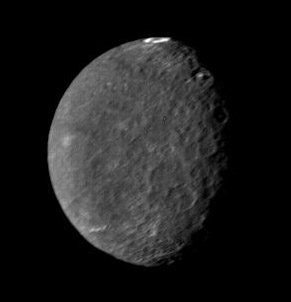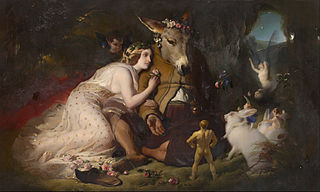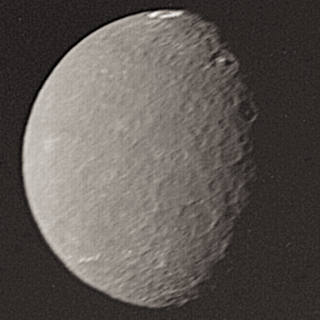
Oberon is a general-purpose programming language first published in 1987 by Niklaus Wirth and the latest member of the Wirthian family of ALGOL-like languages. Oberon was the result of a concentrated effort to increase the power of Modula-2, the direct successor of Pascal, and simultaneously to reduce its complexity. Its principal new feature is the concept of type extension of record types. It permits constructing new data types on the basis of existing ones and to relate them, deviating from the dogma of strictly static typing of data. Type extension is Wirth's way of inheritance reflecting the viewpoint of the parent site. Oberon was developed as part of the implementation of an operating system, also named Oberon at ETH Zurich in Switzerland. The name was inspired both by the Voyager space probe's pictures of the moon of the planet Uranus, named Oberon, and because Oberon is famous as the king of the elfs.

Umbriel is the third-largest moon of Uranus. It was discovered on October 24, 1851, by William Lassell. It was discovered at the same time as Ariel and named after a character in Alexander Pope's 1712 poem The Rape of the Lock. Umbriel consists mainly of ice with a substantial fraction of rock, and may be differentiated into a rocky core and an icy mantle. The surface is the darkest among Uranian moons, and appears to have been shaped primarily by impacts. However, the presence of canyons suggests early endogenic processes, and the moon may have undergone an early endogenically driven resurfacing event that obliterated its older surface.

Rhea is the second-largest moon of Saturn and the ninth-largest moon in the Solar System, with a surface area that is comparable to the area of Australia. It is the smallest body in the Solar System for which precise measurements have confirmed a shape consistent with hydrostatic equilibrium. It was discovered in 1672 by Giovanni Domenico Cassini.

Oberon, also designated Uranus IV, is the outermost and second-largest major moon of the planet Uranus. It is the second-most massive of the Uranian moons, and the tenth-most massive moon in the Solar System. Discovered by William Herschel in 1787, Oberon is named after the mythical king of the fairies who appears as a character in Shakespeare's A Midsummer Night's Dream. Its orbit lies partially outside Uranus's magnetosphere.

Oberon is a king of the fairies in medieval and Renaissance literature. He is best known as a character in William Shakespeare's play A Midsummer Night's Dream, in which he is King of the Fairies and spouse of Titania, Queen of the Fairies.

Merle Oberon was a British actress who began her film career in British films as Anne Boleyn in The Private Life of Henry VIII (1933). After her success in The Scarlet Pimpernel (1934), she travelled to the United States to make films for Samuel Goldwyn. She was nominated for the Academy Award for Best Actress for her performance in The Dark Angel (1935). Oberon hid her mixed heritage out of fear of discrimination and the impact it would have had on her career.
Romeo is the male protagonist in the play Romeo and Juliet.

Titania, also designated Uranus III, is the largest of the moons of Uranus. At a diameter of 1,578 kilometres (981 mi) it is the eighth largest moon in the Solar System, with a surface area comparable to that of Australia. Discovered by William Herschel in 1787, it is named after the queen of the fairies in Shakespeare's A Midsummer Night's Dream. Its orbit lies inside Uranus's magnetosphere.

The Oberon System is a modular, single-user, single-process, multitasking operating system written in the programming language Oberon. It was originally developed in the late 1980s at ETH Zurich. The Oberon System has an unconventional visual text user interface (TUI) instead of a conventional command-line interface (CLI) or graphical user interface (GUI). This TUI was very innovative in its time and influenced the design of the Acme text editor for the Plan 9 from Bell Labs operating system.

Ariel is the fourth-largest moon of Uranus. Ariel orbits and rotates in the equatorial plane of Uranus, which is almost perpendicular to the orbit of Uranus and so has an extreme seasonal cycle.
Oberon is a character appearing in comic books published by DC Comics, created by Jack Kirby. He is the diminutive manager of Mister Miracle, and named after the legendary fairy king Oberon.

Wunda is a large crater on the surface of Uranus' moon Umbriel. It is 131 km in diameter and is located near the equator of Umbriel. The crater is named after Wunda, a dark spirit of Australian aboriginal mythology.
This is a directory of lists of geological features on planets excepting Earth, moons and asteroids ordered by increasing distance from the Sun.

Uranus, the seventh planet of the Solar System, has 28 confirmed moons. Most of them are named after characters that appear in, or are mentioned in, the works of William Shakespeare and Alexander Pope. Uranus's moons are divided into three groups: thirteen inner moons, five major moons, and ten irregular moons. The inner and major moons all have prograde orbits and are cumulatively classified as regular moons. In contrast, the orbits of the irregular moons are distant, highly inclined, and mostly retrograde.

Titania is a character in William Shakespeare's 1595–1596 play A Midsummer Night's Dream.

Hamlet is the largest crater on the known part of the surface of Uranus' moon Oberon. It has diameter of about 206 km and is named after the title character of the play Hamlet, by William Shakespeare. The crater has a dark floor and is surrounded by a system of bright rays, which are ice ejecta deposited during the impact event. The nature of the dark material on the floor is unknown, but it may have erupted from the depth through cryovolcanism. The crater was first imaged by the Voyager 2 spacecraft in January 1986.

The Messina Chasmata are the largest canyon or system of canyons on the surface of the Uranian moon Titania, named after a location in William Shakespeare's comedy Much Ado About Nothing. The 1,492 km (927 mi)- long feature includes two normal faults running NW–SE, which bound a down-dropped crustal block forming a structure called a graben. The graben cuts impact craters, which probably means that it was formed at a relatively late stage of the moon's evolution, when the interior of Titania expanded and its ice crust cracked as a result. The Messina Chasmata have only a few superimposed craters, which also implies being relatively young. The feature was first imaged by Voyager 2 in January 1986.

Ursula is a large crater on Uranus's moon Titania. It is about 135 km across, and is cut by Belmont Chasma. It is named after Hero's attendant in William Shakespeare's comedy Much Ado About Nothing.

Vuver is a crater on the surface of Uranus' moon Umbriel. It is estimated to be 98 km in diameter. The longitude and latitude of its center are 311.6° and −4.7°, respectively.

Rousillon Rupes is a scarp on the surface of the Uranian moon Titania named after "Bertram, count of Rousillon" in William Shakespeare's comedy All's Well That Ends Well. The 402 km long feature is a normal fault situated near the equator and running perpendicular to it. The scarp cuts impact craters, which probably means that it was formed at a relatively late stage of moon's evolution, when the interior of Titania expanded and its ice crust cracked as a result. Rousillon Rupes has only few crater superimposed on it, which also implies its relatively young age. The scarp was first imaged by Voyager 2 spacecraft in January 1986.